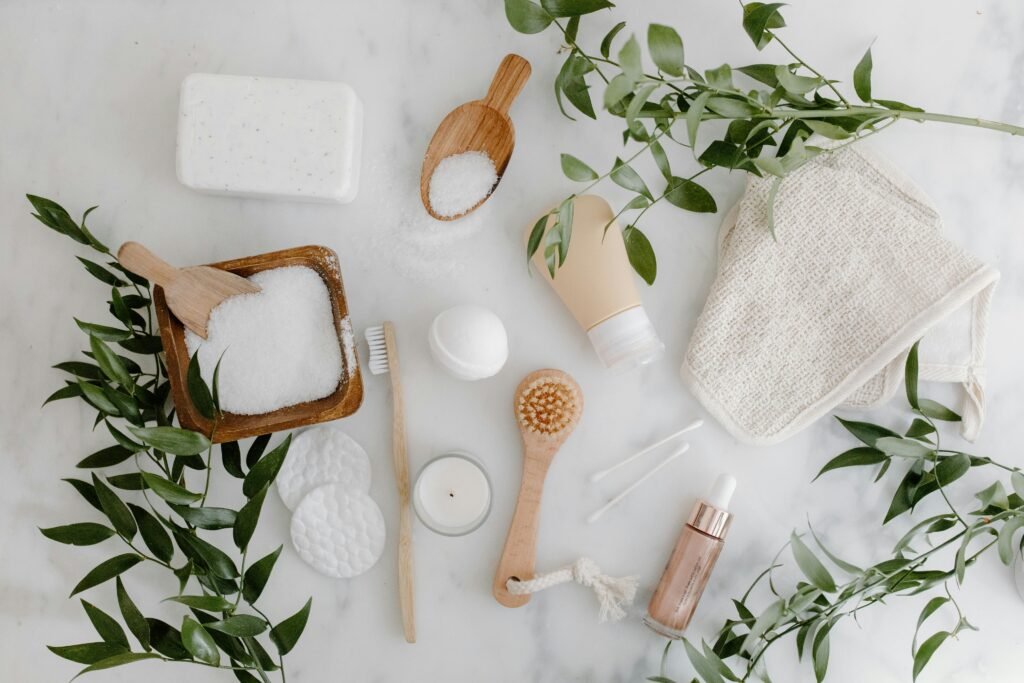
Introduction
Working night shifts can wreak havoc on more than just your sleep schedule and energy levels – It can cause night shift skin problems and premature ageing. If you have noticed your skin looking duller, developing more fine lines or breaking out more frequently since starting night work, you are not imagining things. Night shift work creates a perfect storm of conditions that can accelerate skin aging and trigger various skin problems that day workers rarely experience.
Your skin operates on its own circadian rhythm, just like the rest of your body. During nighttime hours, your skin naturally enters repair mode, producing new cells, repairing damage from daily environmental stressors and boosting collagen production. When you work nights and sleep during the day, this delicate process gets disrupted, leading to visible changes in your skin’s health and appearance.
The combination of artificial light exposure, disrupted sleep patterns, increased stress levels, and irregular eating habits creates an environment where your skin ages faster and becomes more prone to problems like acne, dryness, sensitivity, and premature wrinkles. Understanding these connections is the first step toward developing an effective skincare strategy that works with your unique schedule rather than against it.
Understanding Night Shift Skin Problems

Your skin follows a natural 24-hour cycle that coordinates with your body’s internal clock. During daytime hours, your skin focuses on protection, producing oils and maintaining barrier function to shield against environmental damage. As evening approaches, blood flow to the skin increases and cellular repair processes kick into high gear.
When you work night shifts, exposure to artificial light during these crucial repair hours disrupts your skin’s natural rhythm. Blue light from fluorescent bulbs and computer screens can penetrate deeper into your skin than natural sunlight, potentially causing oxidative stress and accelerating the breakdown of collagen and elastin. These proteins are essential for maintaining skin firmness and elasticity, and their premature breakdown leads to sagging and wrinkle formation.
Sleep deprivation, a common consequence of shift work, directly impacts your skin’s ability to repair itself. During deep sleep, your body releases growth hormone, which stimulates cell turnover and collagen production. When you get insufficient or poor-quality sleep, these repair processes slow down, leaving your skin looking tired and aged.
Cortisol levels also play a significant role in skin health. Night shift work often elevates cortisol, your body’s primary stress hormone, which can trigger inflammatory responses in the skin. Chronic inflammation breaks down collagen faster and can worsen conditions like acne, eczema, and rosacea. High cortisol levels also impair your skin’s barrier function, making it more prone to dryness and sensitivity.
Your skin’s oil production can become irregular when your circadian rhythm is disrupted. Some night shift workers experience increased oiliness and breakouts, while others develop dry, flaky skin. This inconsistency makes it challenging to maintain an effective skincare routine and can lead to confusion about what products to use.
Developing a Night Shift Specific Skincare Routine

Creating an effective skincare routine as a night shift worker requires thinking differently about when and how you care for your skin. Instead of following traditional morning and evening routines, you need to align your skincare with your work schedule and sleep patterns.
Your pre-shift skincare routine should focus on protection and preparation. Cleanse your skin gently to remove any impurities from your sleep period, then apply products that will protect your skin during the long hours ahead. A lightweight moisturizer with antioxidants can help shield your skin from environmental stressors and artificial light exposure during your shift.
Consider using a primer or protective serum that contains ingredients like vitamin C, niacinamide, or zinc oxide. These ingredients help create a barrier against environmental damage and can reduce the impact of artificial light on your skin. If your workplace is particularly dry or air-conditioned, choose products with hyaluronic acid or glycerin to maintain hydration throughout your shift.
During your shift, keep your skincare simple but consistent. If you wear makeup, choose non-comedogenic products that will not clog your pores during the long hours. Blotting papers can help manage excess oil without disturbing your makeup, and a hydrating mist can refresh your skin during breaks.
Your post-shift routine is where the magic happens for skin repair and renewal. This is your equivalent of a nighttime routine, even though it occurs during morning hours. Start with a thorough but gentle cleanse to remove all traces of makeup, sunscreen, and environmental pollutants accumulated during your shift.
After cleansing, apply treatment products that support skin repair and regeneration. Retinol or retinoid products are particularly beneficial for night shift workers because they stimulate cell turnover and collagen production. However, these ingredients make your skin more sensitive to light, so it is crucial to apply them only when you will be sleeping in a dark environment.
Moisturizing becomes even more critical for night shift workers due to the dehydrating effects of artificial environments and disrupted sleep. Choose a rich, nourishing moisturizer that will support your skin’s barrier function while you sleep. Ingredients like ceramides, peptides, and nourishing oils can help repair and strengthen your skin overnight.
Nutritional Strategies for Healthy Skin

Your eating patterns and food choices significantly impact your skin health, and night shift work often disrupts normal eating schedules in ways that can harm your complexion. Irregular meal timing, increased reliance on processed foods, and disrupted nutrient absorption can all contribute to skin problems.
Antioxidants are particularly important for night shift workers because they help combat the oxidative stress caused by disrupted circadian rhythms and artificial light exposure. Focus on incorporating foods rich in vitamins C and E, beta-carotene, and selenium into your meals. Berries, leafy greens, nuts, seeds, and colorful vegetables are excellent sources of these skin-protective compounds.
Omega-3 fatty acids play a crucial role in maintaining healthy skin cell membranes and reducing inflammation. Night shift workers often have higher levels of systemic inflammation, making these healthy fats even more important. Include fatty fish, walnuts, flaxseeds, and chia seeds in your diet regularly.
Hydration affects your skin from the inside out, and night shift workers are often chronically dehydrated due to irregular schedules and increased caffeine consumption. Aim to drink water consistently throughout your shift, but be mindful of timing to avoid disrupting your sleep. Herbal teas can provide hydration along with additional antioxidants and calming compounds.
Protein intake is essential for collagen production and skin repair. Night shift workers sometimes skimp on protein due to irregular eating schedules or reliance on convenient snack foods. Make an effort to include high-quality protein sources like lean meats, fish, eggs, legumes, or plant-based proteins in your meals.
Limit sugar and processed foods, which can trigger inflammatory responses in the skin and accelerate aging through a process called glycation. When you do need quick energy during your shift, choose complex carbohydrates paired with protein to maintain stable blood sugar levels and reduce skin-damaging inflammation.
Managing Stress and Its Impact on Skin

Stress management is crucial for maintaining healthy skin as a night shift worker because shift work inherently creates multiple stressors that can manifest as skin problems. Chronic stress accelerates aging, triggers breakouts, and can worsen existing skin conditions like eczema or psoriasis.
The relationship between stress and skin problems creates a vicious cycle. Poor skin can cause emotional stress and decreased self-confidence, which in turn can worsen skin problems through increased cortisol production and stress-related behaviors like touching or picking at the skin.
Develop stress-reduction techniques that you can use both during and after your shifts. Deep breathing exercises, progressive muscle relaxation, or brief meditation sessions can help lower cortisol levels and reduce the inflammatory responses that damage your skin. Even five to ten minutes of stress reduction techniques can make a noticeable difference in your skin’s appearance over time.
Physical activity is an excellent stress reliever that also benefits your skin by improving circulation and promoting the delivery of nutrients and oxygen to skin cells. However, timing your exercise appropriately is important for night shift workers. Gentle exercise like walking or yoga can be done during your shift or immediately after, while more intense workouts should be scheduled earlier to avoid interfering with your sleep.
Creating boundaries between work stress and personal life becomes even more important when working nights. Develop rituals that help you transition from work mode to rest mode, such as changing clothes, listening to calming music, or practicing gratitude. These transitions help signal to your body that it is time to shift from stress response to repair mode.
Environmental Protection and Light Management

Protecting your skin from environmental damage takes on new dimensions when you work night shifts. While you may have less exposure to harmful ultraviolet rays from the sun, you face increased exposure to artificial light and environmental pollutants that can damage your skin in different ways.
Blue light exposure from computers, smartphones, and fluorescent lighting can penetrate deeper into your skin than traditional indoor lighting. Some research suggests that prolonged blue light exposure may contribute to premature aging and hyperpigmentation. Consider using blue light filtering glasses during your shift, and look for skincare products that contain ingredients like zinc oxide or iron oxides that can provide some protection against blue light.
Air quality in many workplaces can be poor due to recycled air, chemical exposure, or lack of proper ventilation. These environmental factors can contribute to skin irritation, dryness, and premature aging. When possible, take breaks outside for fresh air, and consider using a small air purifier in your workspace if permitted.
The transition between different environments throughout your shift can also stress your skin. Moving from air-conditioned buildings to outdoor heat and humidity, or from warm indoors to cold outdoor temperatures, can disrupt your skin’s barrier function and lead to sensitivity or irritation.
Even though you work nights, you still need sun protection during your commute and any daytime activities. Your skin may be more sensitive to sun exposure due to the use of certain skincare ingredients and the stress of shift work. Apply broad-spectrum sunscreen with at least SPF 30 whenever you will be exposed to sunlight, even for short periods.
Sleep Quality and Skin Recovery

Quality sleep is perhaps the most important factor in maintaining healthy skin as a night shift worker, yet it is also one of the most challenging aspects to manage. Your skin does most of its repair work during deep sleep phases, making sleep quality just as important as sleep duration.
Create an environment that maximizes your sleep quality and supports skin recovery. Your bedroom should be completely dark, as even small amounts of light can interfere with the production of growth hormone and melatonin, both of which are important for skin repair. Consider using blackout curtains, eye masks, and covering any electronic device lights.
Temperature also affects both sleep quality and skin health. Keep your bedroom cool, ideally between 65 and 68 degrees Fahrenheit. Cool temperatures promote deeper sleep and prevent excessive sweating that can clog pores and irritate sensitive skin.
Your pillowcase choice can impact your skin health. Silk or satin pillowcases create less friction against your skin and hair compared to cotton, reducing the risk of irritation and helping to prevent the formation of sleep lines that can become permanent wrinkles over time.
Consider the timing of your skincare routine in relation to your sleep schedule. Apply your most important treatment products, like retinoids or peptide creams, right before sleeping when your skin will have the longest uninterrupted period to absorb and utilize these beneficial ingredients.
Creating Your Personal Skin Health Plan

Developing an effective approach to maintaining healthy skin while working night shifts requires a personalized strategy that considers your specific work environment, skin type, and lifestyle factors. Start by assessing your current skin condition and identifying the primary concerns you want to address, whether that is premature aging, acne, dryness, or sensitivity.
Keep a skin diary for a few weeks, noting changes in your skin’s appearance, breakouts, or irritation in relation to your work schedule, stress levels, diet, and skincare routine. This information can help you identify patterns and triggers that affect your skin health.
Introduce new skincare products gradually, testing one new product at a time for at least a week before adding another. This approach helps you identify which products are beneficial and which might be causing problems. Night shift workers often have more sensitive skin due to stress and disrupted sleep, making this cautious approach even more important.
Consider consulting with a dermatologist who understands the unique challenges faced by shift workers. They can provide personalized recommendations for products and treatments that work well with your schedule and address your specific skin concerns.
Remember that improving your skin health as a night shift worker is a marathon, not a sprint. Consistency with your skincare routine, stress management, and healthy lifestyle choices will yield better results than expensive products or elaborate routines that you cannot maintain long-term. Focus on sustainable practices that fit into your unique schedule and lifestyle, and be patient as your skin adjusts to your new routine
